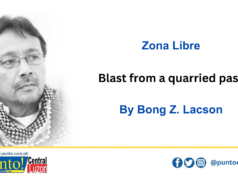BALIUAG, Bulacan— This bustling town in northeastern Bulacan will mark the centennial of buntal hat weaving with a 10-day festival starting today.
Dubbed as “Buntal Festival”, the celebrations will be highlighted by job fair, painting contest, concerts, buntal hat santacruzan, street dancing, search for Lakambini ng Baliuag, and exhibits of products made from woven buntal fibers.
Based on the book “Baliwag then and now” by Rolando Villacorte, buntal hat weaving started in this town sometime between 1907 and 1909 when Mariano Deveza brought to Baliuag some bundle of coarse buntal fiber from his home town of Lucban, Quezon.
Back then, Lucban, Quezon is the sole seat of buntal weaving industry and could not cope with the large demand for the product, while Baliuag was already famous for bamboo hat weaving.
Rosie Decasa, tourism officer of this town and owner of Baliuag Buntal Enterprises, said Deveza first introduced the buntal fibers to the late Dolores Maniquis who became fascinated and experimented with it but softening the fibers using a heavy wooden roller.
Maniquis started weaving the pliant fibers into hats and later experimented with colors using dyes which she first bleached.
Decasa said that buntal hat weaving became a booming industry in this town by 1910 with literally almost every household had a weaver.
As the industry grew, specialization set in and improved production methods became standard practice.
She said that to finish a hat, four persons are needed.
The weaver who would take care of the hat’s crown or head, then the weaver who would make the brim. The third weaver would finish or close the brim, while the fourth would bleach the yellowish fiber to make it more attractive.
Decasa said that by 1920, Baliuag buntal hat became a great dollar earning export, as it is sold in the world market and became known as “Panama hat.”
However, by late 1920, the industry suffered from cutthroat competition from China as the Chinese started producing their version of “balibuntals” with raw materials imported from the Philippines.
Decasa said that in 1923, Chinese businessmen in Hongkong hired Filipino weavers, and before the war, the industry was in virtual collapse.
However, after the war, the industry began to thrive anew under the Balibuntal Straw Hat outfit of the late Joaquin Villones which had about 5,000 weavers and suppliers.
Records showed that Villones outfit was able to manufacture at least a quarter of the 40,000 total monthly production by the 1960s.
Today, buntal hat weaving continues to thrive here, but manufacturers like Decasa are facing lack of skilled manpower.
“We still have hundreds of weavers, but they mostly do it on part time basis,” Decasa said and noted her willingness to offer technology transfer to young workers through workshops and seminars.
She said that she is also willing help train detainees in different jails to learn how to weave, thereby held the industry survive.
As this developed, Feliza Ramos, 92 of this town said that economic crisis have reduced the possibility of increase production of buntal hat.
As one of the oldest living buntal weaver, Ramos wove her last buntal hat two years ago.
For her part, Pilar Bernardo, 98 said that not too many young people were interested in buntal hat weaving today.
“Noong panahon namin, lahat kami at gumagawa niyan, pero ngayon iba na interes ng mga kabataan,” she said noting that she started weaving in the early part of her teenage years.
Dubbed as “Buntal Festival”, the celebrations will be highlighted by job fair, painting contest, concerts, buntal hat santacruzan, street dancing, search for Lakambini ng Baliuag, and exhibits of products made from woven buntal fibers.
Based on the book “Baliwag then and now” by Rolando Villacorte, buntal hat weaving started in this town sometime between 1907 and 1909 when Mariano Deveza brought to Baliuag some bundle of coarse buntal fiber from his home town of Lucban, Quezon.
Back then, Lucban, Quezon is the sole seat of buntal weaving industry and could not cope with the large demand for the product, while Baliuag was already famous for bamboo hat weaving.
Rosie Decasa, tourism officer of this town and owner of Baliuag Buntal Enterprises, said Deveza first introduced the buntal fibers to the late Dolores Maniquis who became fascinated and experimented with it but softening the fibers using a heavy wooden roller.
Maniquis started weaving the pliant fibers into hats and later experimented with colors using dyes which she first bleached.
Decasa said that buntal hat weaving became a booming industry in this town by 1910 with literally almost every household had a weaver.
As the industry grew, specialization set in and improved production methods became standard practice.
She said that to finish a hat, four persons are needed.
The weaver who would take care of the hat’s crown or head, then the weaver who would make the brim. The third weaver would finish or close the brim, while the fourth would bleach the yellowish fiber to make it more attractive.
Decasa said that by 1920, Baliuag buntal hat became a great dollar earning export, as it is sold in the world market and became known as “Panama hat.”
However, by late 1920, the industry suffered from cutthroat competition from China as the Chinese started producing their version of “balibuntals” with raw materials imported from the Philippines.
Decasa said that in 1923, Chinese businessmen in Hongkong hired Filipino weavers, and before the war, the industry was in virtual collapse.
However, after the war, the industry began to thrive anew under the Balibuntal Straw Hat outfit of the late Joaquin Villones which had about 5,000 weavers and suppliers.
Records showed that Villones outfit was able to manufacture at least a quarter of the 40,000 total monthly production by the 1960s.
Today, buntal hat weaving continues to thrive here, but manufacturers like Decasa are facing lack of skilled manpower.
“We still have hundreds of weavers, but they mostly do it on part time basis,” Decasa said and noted her willingness to offer technology transfer to young workers through workshops and seminars.
She said that she is also willing help train detainees in different jails to learn how to weave, thereby held the industry survive.
As this developed, Feliza Ramos, 92 of this town said that economic crisis have reduced the possibility of increase production of buntal hat.
As one of the oldest living buntal weaver, Ramos wove her last buntal hat two years ago.
For her part, Pilar Bernardo, 98 said that not too many young people were interested in buntal hat weaving today.
“Noong panahon namin, lahat kami at gumagawa niyan, pero ngayon iba na interes ng mga kabataan,” she said noting that she started weaving in the early part of her teenage years.




